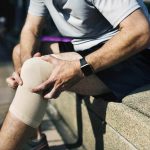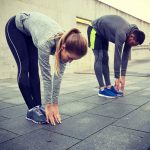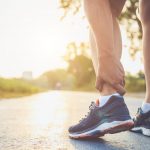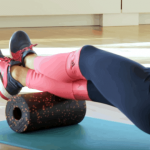To understand the benefits of using a massage gun, we must first understand what a massage gun is.
What is a Massage Gun?
A massage gun is a muscle recovery tool that offers deep tissue massage by means of pounding motion into the muscle area rapidly using the percussive therapy technique. A massage gun is sometimes called a self-myofascial release tool or a percussion massager.
Now that we roughly know what a massage gun is, let’s look into the benefits of using a massage gun.
Benefits of Using a Massage Gun
As mentioned in the article on history of massage guns, it was developed as a handheld percussion massager to be used on fatigued muscles, stress relief and other muscle related soreness.
So, what exactly do you benefit from when using a massage gun?
Here are 5 reasons to answer your curiosity.
1. Improves Flexibility and Delayed-Onset Muscle Soreness (DOMS)
 According to a study1 of 1012 participants conducted by Davis et.al, it is concluded that sports massage improves flexibility and DOMS.
According to a study1 of 1012 participants conducted by Davis et.al, it is concluded that sports massage improves flexibility and DOMS.
Until recently, there were no studies carried out on massage guns so another group of researchers did the first ever study using a massage gun to test the effect of a 5-minute massage on the calf muscles.
Konrad et. al.2 found that there is an increase in the range of motion after using a massage gun on the calf muscle of participants.
The team of researchers also concluded with the suggestion of using a massage gun for percussive massage treatment as a warm-up for athletes. Using it regularly can help optimise the athletes’ flexibility without losing muscle performance.
Did you ever feel stiff and sore muscles the day after an intense workout? That is the most common feeling of delayed-onset muscle soreness (DOMS). The vibration and percussive massages produced by a massage gun can help loosen up those muscle tension providing improved flexibility.
I have tried massage guns myself and I love using them after each workout session and they truly work wonders.
2. Release the Build Up of Lactic Acid
 A study found that vibration therapy helps to raise skin temperature and increase blood flow, which in turn reduces the build up of lactic acid3 within the blood.
A study found that vibration therapy helps to raise skin temperature and increase blood flow, which in turn reduces the build up of lactic acid3 within the blood.
If you look at the mechanical design of a massage gun, it does exactly that. The action of tapping into the muscles creating a form of vibration therapy.
By using a massage gun, blood flow to the area increases and helps release lactic acid formed in the surrounding tissues. Lactic acid forms during intense workout, which can cause the feeling of muscle fatigue and tension.
With the improved blood circulation, more oxygen is able to reach the muscles to help the body recover from lactic acid production.
3. Breaks Up Scar Tissue
 Besides those benefits, another advantage to using a massage gun is that the trigger pointing it offers helps to break up scar tissues. Trigger pointing is one of the techniques physiotherapists use to break down scar tissue.
Besides those benefits, another advantage to using a massage gun is that the trigger pointing it offers helps to break up scar tissues. Trigger pointing is one of the techniques physiotherapists use to break down scar tissue.
According to Physio.co.uk, increased temperature of the scar tissue during a massage can increase the tissue flexibility. This also improves the elasticity of the scar tissue so it can be easily broken down to improve the range of motion. Scar tissue can be restrictive and limits motion, which can result in pain.
The breakdown of scar tissue not only helps with the pain management but can also help in improving the appearance of scarring.
The massage gun also uses trigger pointing so there is a similarity in gaining the benefit of breaking up scar tissues. Of course the massage gun does not replace the quality the healthcare professionals like physiotherapists provide. A handheld percussive tool is meant to supplement your needs.
4. Help with Rehabilitation
 This point kind of relates back to the main reason why a massage gun was developed. The inventor was injured in an accident and was dealing with pain so he invented a percussion massager, which we know today as a massage gun to help with his pain.
This point kind of relates back to the main reason why a massage gun was developed. The inventor was injured in an accident and was dealing with pain so he invented a percussion massager, which we know today as a massage gun to help with his pain.
So yes, using a massage gun can help with rehab. However, you should always consult with your physician before using one on yourself to prevent further injury.
When a massage gun is used to stimulate the muscle tissues, there is an improved blood circulation to the area. This increased blood flow to the injured area increases flexibility in the muscle fibres and allows them to heal quicker.
5. Saves You Time
 Lastly, this is a no brainer because you will definitely be saving lots of time when using a massage gun. To achieve a similar effect from using a foam roller, you can get it for a quarter of the time.
Lastly, this is a no brainer because you will definitely be saving lots of time when using a massage gun. To achieve a similar effect from using a foam roller, you can get it for a quarter of the time.
Athletes usually spend about 1 hour on a foam roller as compared to using only about 15 minutes using a massage gun. This is not to say that foam roller is not effective but each to its own.
Some people enjoy using a foam roller more than a massage gun but I personally enjoy the massage gun more. I like the more pinpointed pressure on my tension knots and quicker result.
There are more benefits to using a massage gun, which I couldn’t cover but as always, do your research before determining if you need one.
If you’ve decided you want one but are torn on which ones to get, I may have an article that may be beneficial to you. I made a review on the top massage guns in Australia complete with a comparison table.
Source
1. Holly Louisa Davis, Samer Alabed, Timothy James Ainsley Chico, Effect of sports massage on performance and recovery: a systematic review and meta-analysis , BMJ Open Sport Exerc Med. 2020 May 7;6(1):e000614., doi: 10.1136/bmjsem-2019-000614. eCollection 2020.
2. Andreas Konrad, Christoph Glashüttner,Marina Maren Reiner,Daniel Bernsteiner, and Markus Tilp, The Acute Effects of a Percussive Massage Treatment with a Hypervolt Device on Plantar Flexor Muscles’ Range of Motion and Performance, J Sports Sci Med. 2020 Dec; 19(4): 690–694.
Published online 2020 Nov 19.
3. Shagufta Imtiyaz, Zubia Veqar, and M.Y. Shareef, To Compare the Effect of Vibration Therapy and Massage in Prevention of Delayed Onset Muscle Soreness (DOMS) , J Clin Diagn Res. 2014 Jan; 8(1): 133–136. Published online 2014 Jan 12. doi: 10.7860/JCDR/2014/7294.3971